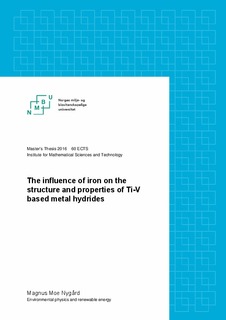| dc.description.abstract | The influence of iron on the crystalline structure and hydrogen sorption properties of a metal hydride system based upon Ti0.70V0.30 have been studied. The aim is to determine whether the expensive vanadium could be substituted by the much cheaper ferrovanadium in such titanium-rich metal hydrides. Six alloys of (Ti0.70V0.30)1-zFez with z ∈{0,0.03,0.06,0.10,0.20,0.30} where successfully synthesised by arc melting and the crystalline phases were determined by synchrotron-radiation powder diffraction. The thermodynamic properties of the alloys were studied in Sieverts apparatus and by differential scanning calorimetry. Changes in the phase composition during hydrogen sorption were for selected systems followed by in-situ synchrotronradiation powder diffraction.
The alloys form body-centred cubic crystal structures for all the considered compositions. The addition of iron cause the unit cell of the bcc phase to contract, and the lattice parameter is observed to decrease linearly with increasing iron content. The bcc phase is obtained alongside a small fraction of an hexagonal impurity phase which seem to be a solid solution of Ti,V and Fe that participate in the hydrogenation. The bcc alloys form face-centred-cubic related dihydrides when exposed to low pressures of hydrogen if the content of iron is less than 10 at.%. Within this range the hydrogen capacities are not significantly influenced by the addition of iron and reach ∼ 3.5 wt.%. Beyond these values the capacity rapidly decrease. The absorption kinetics are fast, and the reaction is complete within minutes when exposed to modest hydrogen pressures of ∼ 20 bar. The resultant dihydrides seem to contain defects such as stacking faults and twin boundaries that prohibit structural refinement to be conducted. Pressure-composition isotherms have been measured at temperatures below 120 ◦C. These reveal that there is a single plateau with a plateau-pressure below the sensitivity of the measurements. The iron does not seem to influence the plateau-pressure, but the increased content of iron lower the enthalpy, onset temperature and activation energies for desorption. | nb_NO |

